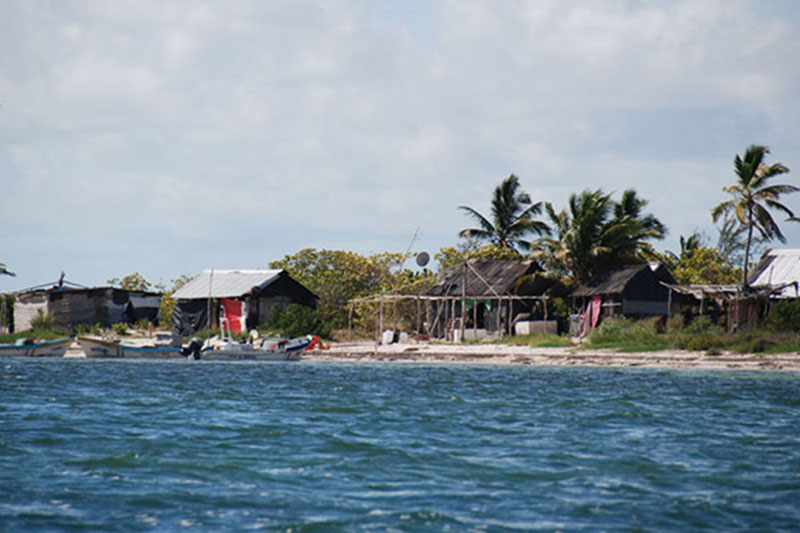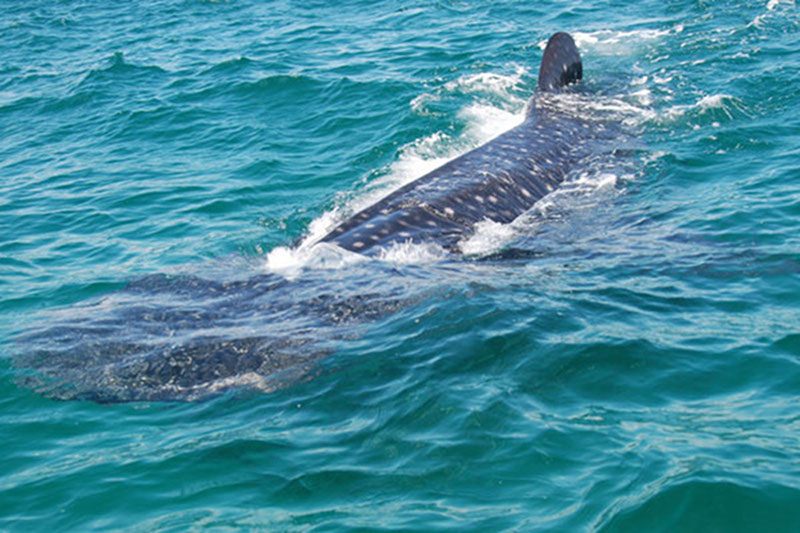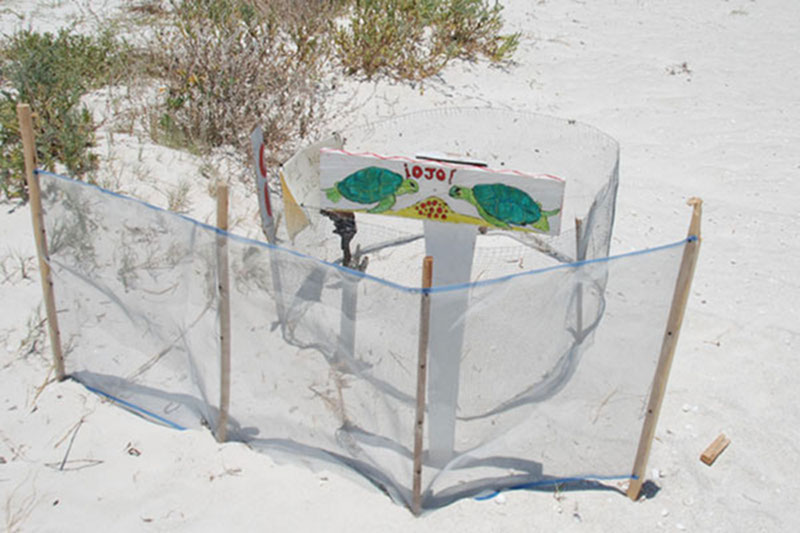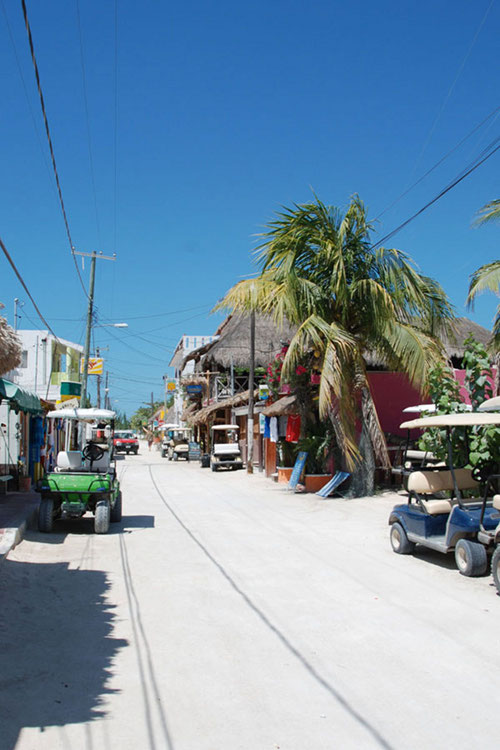
By Emily McDonald, Web Coordinator/Field Operations Specialist - NOAA Office of Ocean Exploration and Research / 2020 Company, LLC
October 14, 2011

The small fishing-village of Cabo Catoche is located at the northern-most tip of the Yucatan Peninsula where the waters of the Gulf of Mexico and Caribbean Sea converge. The confluence of these two bodies of water creates very productive waters and an environment ideal for fishing. Image courtesy of Proyecto Costa Escondida Maritime Maya 2011 Expedition, NOAA-OER. Download larger version (jpg, 309 KB).
The whale shark (Rhincodon typus), or known in the Yucatan as el Tiburon Ballena is the largest living species of fish. They are slow-moving filter-feeders, and are found mostly in warm tropical oceans. Whale sharks can grow up to over 40ft long and have a distinctive spotted pattern on their skin. While not endangered, the species is listed as vulnerable. Click image for larger view and image credit.

The whale shark (Rhincodon typus), or known in the Yucatan as el Tiburon Ballena is the largest living species of fish. They are slow-moving filter-feeders, and are found mostly in warm tropical oceans. Whale sharks can grow up to over 40ft long and have a distinctive spotted pattern on their skin. While not endangered, the species is listed as vulnerable. Image courtesy of Proyecto Costa Escondida Maritime Maya 2011 Expedition, NOAA-OER. Download larger version (jpg, 445 KB).
While the ancient Miradors, Sacbes and ball courts have been enveloped by the jungle or are the focus of tourist attractions, the descendants of the Maya still live in the land of their ancestors, and have adapted to live and work in the modern world. For some of the modern Maya, the marine environment still provides a source of livelihood in either the form of fishing or eco-tourism.
Leaving the protected estuary of Laguna Holbox, where the yellow-brown waters of the Gulf of Mexico meet the blue-green waters of the Caribbean Sea, exists the small fishing village of Cabo Catoche. The confluence of the gulf and the sea create an incredibly rich and productive marine environment, ideal for fishing. Fishermen come from nearby towns, such as Chiquila to live and fish at Cabo Catoche. A small village of thatch and tin-roof huts lines the shoreline, while small lanchas bob just off-shore waiting to take fishermen out to the deep, productive waters.
In addition to providing a productive fishing industry for the modern Maya, the rich waters off the northern Yucatan have recently opened up a large eco-tourism industry as for about five months out of the year; they are home to one of the largest gatherings of whale sharks, or el Tiburon ballena. The large filter-feeding sharks attract thousands of tourists from around the globe each year. While a protected species, under strict regulations, tourists can view the sharks in their natural environment and even take a quick swim with them. During the brief season, which runs from late May through September, local Maya fishermen and guides take small groups of tourists out to observe these magnificent creatures. The productive waters entice not only the whale sharks, but manta rays and dolphins as well, making this area an eco-tourism gem. Many of the tours also expose visitors to Cabo Catoche and give them the opportunity to fish with a simple hook and line and then eat what they catch for lunch.

A large portion of the northern Yucatan, including Isla Holbox is protected as part of the Yum-Balam Biosphere Reserve. Here, a turtle nest is protected and marked on Isla Holbox to keep both tourists and residents from disturbing it. Image courtesy of Proyecto Costa Escondida Maritime Maya 2011 Expedition, NOAA-OER. Download larger version (jpg, 269 KB).

In addition to marine life, flamingos and other tropical birds draw eco-tourists to the northern Yucatan and Isla Holbox. Image courtesy of Proyecto Costa Escondida Maritime Maya 2011 Expedition, NOAA-OER. Download larger version (jpg, 231 KB).
Isla Holbox is the main launching point for many whale shark expeditions, and this historically fishing town, is blossoming into a small, but bustling eco-tourism destination. Only 7 ½ miles long and one mile wide, the small barrier island hosts a number of hotels, restaurants and shops, many focused on the area’s natural attractions. You won’t find any chain hotels or restaurants on the island – most of them are small, locally-owned and operated businesses. In addition to the whale shark tours, the island is a popular birding site, as it is inhabited by many exotic species, including large flocks of flamingos. The island is part of the larger Yum-Balam Biosphere Reserve and the natural environment on the island is monitored and protected closely to work to keep it a healthy and flourishing area for wildlife.

There are no cars – only golf carts on the sand-paved streets of Isla Holbox. The small town in largely sustained by the eco-tourism and fishing industries. Image courtesy of Proyecto Costa Escondida Maritime Maya 2011 Expedition, NOAA-OER. Download larger version (jpg, 320 KB).
While over the past centuries, the landscape, ecology and societies of the northern Yucatan have changed, the Maya still remain an integral part of the area and have adapted to survive in the modern world, yet still maintain a close connection to the area’s unique ecology and environment.